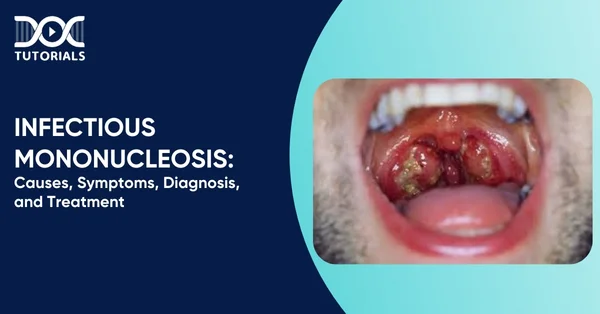Infectious Mononucleosis: Causes, Symptoms, Diagnosis, and Treatment

Mononucleosis, or “mono,” is an infectious disease most commonly caused by the Epstein-Barr virus (EBV), a herpes virus. Although other viruses can sometimes trigger the disease, EBV is still the primary cause. The disease most frequently affects teens and young adults and is typically marked by symptoms like severe fatigue, fever, sore throat, and muscle aches.
While there is no guaranteed cure, supportive therapy helps resolve symptoms to allow the body to recover from the infection itself. For medical students who are appearing for the NEET PG exam, infectious mononucleosis is an important topic to study that has concepts of immune response, viral pathogenesis, and lymphoid tissue involvement.
Having a solid foundation on such topics can give depth to learning associated systems and increase clinical acumen. Keep reading for a detailed insight.
What is Infectious Mononucleosis?
Infectious mononucleosis is a contagious disease, often caused by the Epstein-Barr virus. Even though EBV is by far the most common cause, there are other viral causes of the disease as well. The disease is most common among young adults and adolescents, particularly those in college.
Research indicates that at least 25% of those young adults or adolescents infected with EBV will develop a case of infectious mononucleosis.
What Causes Infectious Mononucleosis?
Epstein-Barr virus is the most common aetiology of infectious mononucleosis, but other etiologies can also be responsible in a few instances. Transmission is typically secondary to contact with infected bodily fluids, especially saliva.
Consequently, kissing, sharing food, utensils, and even respiratory droplets can all contribute to transmission. In less common scenarios, the virus may also be transmitted through blood transfusions, sexual contact, or organ transplants.
Besides EBV, there are quite a number of infections that have been discovered to cause mononucleosis-like syndromes. They are:
- Cytomegalovirus (CMV)
- Toxoplasmosis
- Human Immunodeficiency Virus (HIV)
- Rubella
- Hepatitis A, B, or C
- Adenovirus
What are the Symptoms of Infectious Mononucleosis?
This condition typically lasts one to two months, although it varies from individual to individual in terms of severity and symptomatology. Typical mononucleosis symptoms are:
- High-grade fever
- Swollen lymph glands on the neck, under the arms, or in the groin
- Prolonged fatigue
- White patches on the back of the throat
- Enlargement of the spleen
- Headache and body pains
- Rash
- Inflammation of the liver, in some instances, causes jaundice—a yellowing of the eyes and skin due to high levels of bilirubin
Once the acute phase has passed, the virus remains latent in the person’s throat and blood cells for a lifetime. However, recurrence is unlikely if the immune system is severely compromised. Since the symptoms can resemble those of other diseases, a proper medical consultation is needed for an official diagnosis.
How is Infectious Mononucleosis Diagnosed?
To verify a diagnosis of infectious mononucleosis, physicians will look for the patient’s symptoms and may even include some blood tests. These are:
- White Blood Cell Count: A high level of atypical lymphocytes will verify the diagnosis.
- EBV-Specific Antibodies: These help determine whether EBV or another virus, like CMV, is the cause.
- Heterophile Antibody Test (Monospot Test): This is a quick diagnostic test for infectious mononucleosis. While very popular, the test sometimes produces false positives in other conditions or false negatives even though infectious mononucleosis is present.
How is Infectious Mononucleosis Treated?
Treatment of mononucleosis varies with age, general health, and severity of symptoms. Since antiviral drugs do not shorten recovery time, treatment is mainly supportive care, which may involve:
- Rest sufficiently to allow the immune system to fight the infection
- Take plenty of fluids to prevent dehydration
- Take pain-relieving and fever-reducing over-the-counter medication
- Steer clear of contact sports and use minimal pressure on the abdomen to avoid splenic injury
- Use corticosteroids in certain situations to control marked swelling of the tonsils or the throat
What are the Complications of Infectious Mononucleosis?
Though rare, complications may arise sometimes and can include:
- Ruptured spleen
- Kidney inflammation
- Hemolytic anemia
- Neurological diseases like encephalitis or meningitis
- Inflammation of the heart muscle
- Abnormal heart rhythm
- Obstruction of the airway by enlarged tonsils or lymph nodes
FAQs About Infectious Mononucleosis
- How long does fever last in infectious mononucleosis?
Symptoms of infectious mononucleosis usually improve within 2 to 4 weeks for the majority of people. Specific symptoms, though, resolve at unpredictable rates. Sore throat typically improves within 3 to 5 days, and fever may last as long as 10 to 14 days before gradually subsiding.
- Which organ can be severely affected by infectious mononucleosis?
The spleen is most commonly affected during a mono-infection. In rare but severe cases, the spleen can become so enlarged that it ruptures, causing sharp and sudden pain in the upper left abdomen. If such pain continues, it is vital to seek medical help immediately, as surgery may be required.
- Which virus causes infectious mononucleosis?
Epstein-Barr virus (EBV) is the primary virus responsible for mono. Other viruses, such as CMV and adenovirus, however, can sometimes be responsible for the condition. The condition is prevalent among young adults and teenagers.
- Can mononucleosis be prevented?
There is no sure method to avoid contracting mononucleosis. Refraining from such acts as kissing or sharing personal items, such as eating and drinking utensils, with an infected person when they are symptomatic will reduce the risk of infection.
- What kind of antibodies are made in infectious mononucleosis?
The immune response to EBV infection is typically characterised by the development of both IgM and IgG antibodies to viral capsid antigens (VCA). The antibody pattern is also found before the illness develops, thus facilitating early detection of the disease in some cases.
Conclusion
Infectious mononucleosis is generally a self-limiting disease, and the acute illness lasts about two weeks. Recovery is variable 20% of patients recover well enough to return to work or school within one week, and 50% are able to return in two weeks. The fatigue can persist for several more weeks and, in almost 10%, months.
Death is infrequently caused by severe complications like encephalitis, splenic rupture, or airway obstruction in fewer than 1% of patients. Monitor closely for symptoms and consult a healthcare provider if symptoms are worsening.
For NEET PG aspirants, a clear understanding of high-yield topics like infectious diseases is essential. Platforms like DocTutorials offer well-planned study material like subject matter expert video lectures, in-depth subject revision, and efficient, quick revision programs (QRP) to help the candidates solidify their preparation and build confidence.
Enrol in the DocTutorials NEET PG course and step ahead towards your medical future!
Latest Blogs
-

NEET SS Exam 2024: Analysis, Key Dates, Counselling
The NEET SS 2024 exam kicked off on March 29, 2025. Over two days and two slots, candidates across 13…
-

NEET PG Registration 2025: An Essential Guide For Exam Prep
The NEET PG registration, which is conducted online, is a crucial step in the exam process. Filling out the NEET…
-

NEET PG Syllabus 2026: A Must-Have Complete Guide for Exam Success
The NEET PG Syllabus acts as one of the foundation stones for aspiring postgraduate medical students like you who are…




